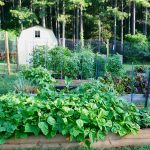As you can image, with temperatures soaring near 70 and bright sunny skies, I was out in the garden for many hours. On Saturday, we finished off “the boat” as we now call the long octagonal flower bed in the back of the house. John fussed more with the underground sprinkler line. I think it’s fine, but he’s not satisfied with the connector to the house. We’re trying to get the backyard done so that the patio can be finished. I’m super excited about that, not just because we get another outdoor living space that overlooks the back fields and woods, but because John mentioned to the electrician who came to bid on the job that we are going to put a pond into the little flower garden. I’ve wanted a pond forever! We found a natural-looking fountain at Lowe’s last year, so we are going to wait until the fall when hopefully it will go on sale. We planted more shrubs into the perennial garden and walked the property, noting the next projects to work on while we replenished the soil in the bare patches on the lawn.
The biggest project by far was finishing the front beds in front of the porch. What looked like a simple job of digging a few holes for azaleas and perennials turned into a pick axe and many smashed fingers. We’d both forgotten that the area near the foundation of a house is always packed with hard pan, clay and gravel from construction. Poor perennials. At least today they are getting watered!
I designed a perennial combination right by the front steps that I think will be lovely once it fills in. I used aalvia “May Night” in the back, and planted some rich dark pink dianthus in front, along with lighter pink phlox. I like how the dark blue-purple flowers and gray-green leaves of the salvia look with the textures and colors of the dianthus. The deer ate the flowers right off of my phlox last year in the perennial garden, but this close to the front steps I doubt they’ll find it. I planted something new with blue, star-shaped flowers whose name escapes me. I’ll have to pop outside and look at the tag. If it wasn’t pouring rain, I’d take a few photos of the perennial combination too and post them. Maybe tomorrow….
In the vegetable garden, carrot seeds went in this weekend. I’ll wait another week or two, then direct sow the seeds. The onions continue to thrive, and the radishes too. The spinach is rapidly overtaking both the Swiss chard and broccoli rabe in terms of growth, but the lettuce is already looking a bit peaked. The strawberries are really runnning wild, but more poor blueberries are dry, brittle sticks. Ah well. Learning to garden in a new area always takes time. Gardeners need a lot of things. Rain, sun, time and patience among others!




